engine RENAULT TWIZY 2018 User Guide
[x] Cancel search | Manufacturer: RENAULT, Model Year: 2018, Model line: TWIZY, Model: RENAULT TWIZY 2018Pages: 118, PDF Size: 2.51 MB
Page 40 of 118
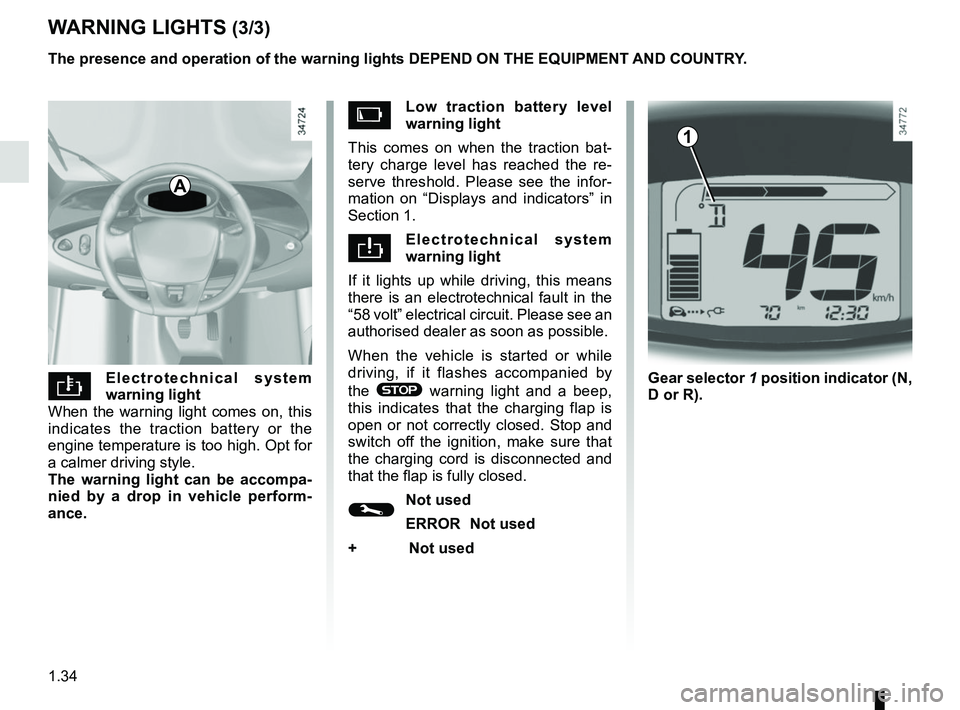
1.34
\bLow traction battery level
warning light
This comes on when the traction bat-
tery charge level has reached the re-
serve threshold. Please see the infor-
mation on “Displays and indicators” in
Section 1.
Electrotechnical system
warning light
If it lights up while driving, this means
there is an electrotechnical fault in the
“58 volt” electrical circuit. Please see an
authorised dealer as soon as possible.
When the vehicle is started or while
driving, if it flashes accompanied by
the
® warning light and a beep,
this indicates that the charging flap is
open or not correctly closed. Stop and
switch off the ignition, make sure that
the charging cord is disconnected and
that the flap is fully closed.
©Not used
ERROR Not used
+ Not used
WARNING LIGHTS (3/3)
Electrotechnical system
warning light
When the warning light comes on, this
indicates the traction battery or the
engine temperature is too high. Opt for
a calmer driving style.
The warning light can be accompa-
nied by a drop in vehicle perform-
ance. The presence and operation of the warning lights DEPEND ON THE EQUIPMENT\
AND COUNTRY.
A
Gear selector 1 position indicator (N,
D or R).
1
Page 45 of 118

1.39
HORN
Electric vehicles are particularly quiet.
This system enables you to warn
people of your presence – especially
pedestrians and cyclists.
Activating the system
With the engine running, turn centre
ring 1 on the stalk until the symbol
ṫ
faces mark 2.
Deactivating the system
Turn the centre ring 1 to position 0
again.
12
Page 46 of 118

1.40
áMain beam headlightsWith the stalk A in position
k, pull it towards you. An indicator
light on the instrument panel will come
on.
To return to the dipped headlights posi-
tion, pull stalk A towards you again.
eSwitching off the lightsReturn the stalk to its original
position. When the engine is started,
the dipped headlights stay on. They will
go out once the engine is switched off.
EXTERIOR LIGHTING AND SIGNALS (1/2)
Daytime running lights
The dipped headlights come on without
using the stalk A when the engine is
started.
uSide lights
Turn end 1 of stalk A until the
symbol is opposite mark 2.
The instrument panel lighting dims.
A
kDipped beam
headlights
Manual operation
Turn end 1 of stalk A until the symbol is
opposite mark 2.
With the ignition switched off, it is not
possible to operate the lights (to avoid
lights being used when parked).
21
A
When the vehicle is driven at
maximum permissible load (refer
to the information on «Weights» in
section 6), you must have the dipped
beam headlights adjusted, while it is
being used, by an Approved Dealer.
Page 49 of 118

2.1
Section 2: Driving
(advice on use relating to fuel economy and the environment)
Starting, stopping the engine . . . . . . . . . . . . . . . . . . . . . . . . . . . . . . . . . . . . \
. . . . . . . . . . . . . . . . . . . 2.2
Gear control . . . . . . . . . . . . . . . . . . . . . . . . . . . . . . . . . . . . \
. . . . . . . . . . . . . . . . . . . . . . . . . . . . . . . . 2.3
Handbrake . . . . . . . . . . . . . . . . . . . . . . . . . . . . . . . . . . . . \
. . . . . . . . . . . . . . . . . . . . . . . . . . . . . . . . . 2.5
Vehicle range: advice . . . . . . . . . . . . . . . . . . . . . . . . . . . . . . . . . . . .\
. . . . . . . . . . . . . . . . . . . . . . . . 2.6
Environment . . . . . . . . . . . . . . . . . . . . . . . . . . . . . . . . . . . .\
. . . . . . . . . . . . . . . . . . . . . . . . . . . . . . . 2.8
Charge meter. . . . . . . . . . . . . . . . . . . . . . . . . . . . . . . . . . . . \
. . . . . . . . . . . . . . . . . . . . . . . . . . . . . . . 2.9
Eco-consumption . . . . . . . . . . . . . . . . . . . . . . . . . . . . . . . . . . . . \
. . . . . . . . . . . . . . . . . . . . . . . . . . . . 2.9
Page 50 of 118

2.2
“Accessories” position ANo power-consuming device will oper-
ate when the ignition is switched off.
“On” position MThe ignition is switched on:
Start position D
Starting the engine
Turn the key to the D position and hold
it in this position until you hear a beep.
Release the key.
As soon as warning light
Ṑ stops
flashing, your vehicle is ready to drive.“Stop, steering and
handbrake lock” position St
To unlock: turn the key and the steering
wheel slightly.
To lock: remove the key and turn the
steering wheel until the steering column
locks.
To release the handbrake, please see
the information on “Handbrake” in
Section 2.
STARTING, STOPPING THE ENGINE
The vehicle cannot be started if the
charging cord is plugged in and
powered or if the charging flap is
open.
Stopping the engine
Bring the key to “Stop” position.
Warning light
Ṑ goes out.
Driver’s responsibility
when parking or stopping
the vehicle
Never leave an animal,
child or adult who is not self-suffi-
cient alone on your vehicle, even for
a short time.
They may pose a risk of injury, such
as by starting the engine or activat-
ing equipment.
Risk of serious injury.
Page 51 of 118
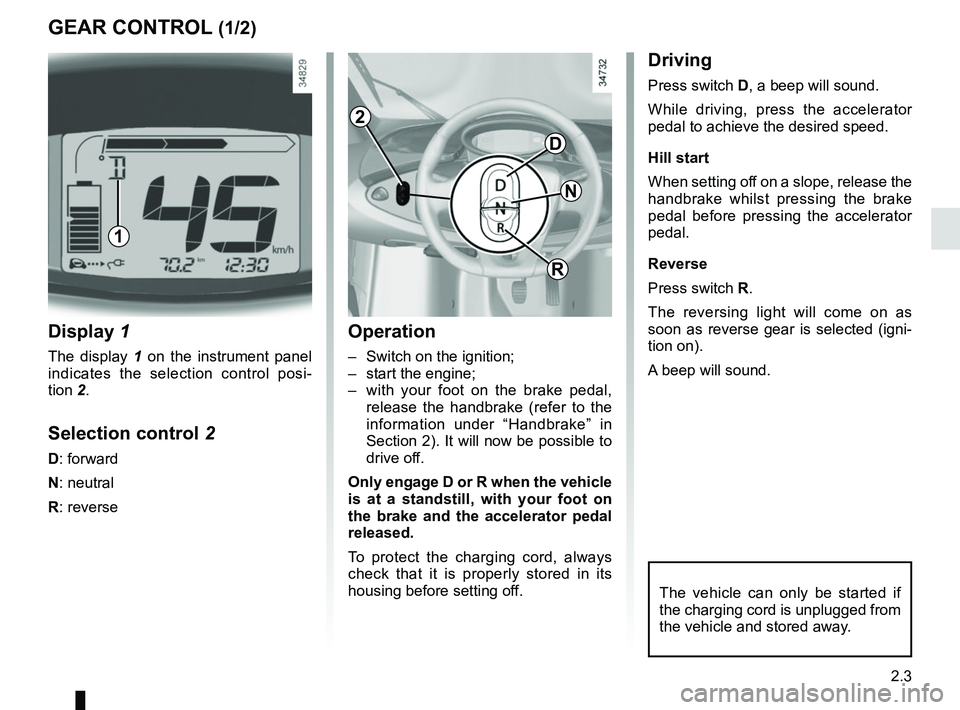
2.3
Driving
Press switch D, a beep will sound.
While driving, press the accelerator
pedal to achieve the desired speed.
Hill start
When setting off on a slope, release the
handbrake whilst pressing the brake
pedal before pressing the accelerator
pedal.
Reverse
Press switch R.
The reversing light will come on as
soon as reverse gear is selected (igni-
tion on).
A beep will sound.
GEAR CONTROL (1/2)
Display 1
The display 1 on the instrument panel
indicates the selection control posi-
tion 2.
Selection control 2
D: forward
N: neutral
R: reverse
Operation
– Switch on the ignition;
– start the engine;
– with your foot on the brake pedal,
release the handbrake (refer to the
information under “Handbrake” in
Section 2). It will now be possible to
drive off.
Only engage D or R when the vehicle
is at a standstill, with your foot on
the brake and the accelerator pedal
released.
To protect the charging cord, always
check that it is properly stored in its
housing before setting off.
The vehicle can only be started if
the charging cord is unplugged from
the vehicle and stored away.
1
D
N
R
2
Page 52 of 118
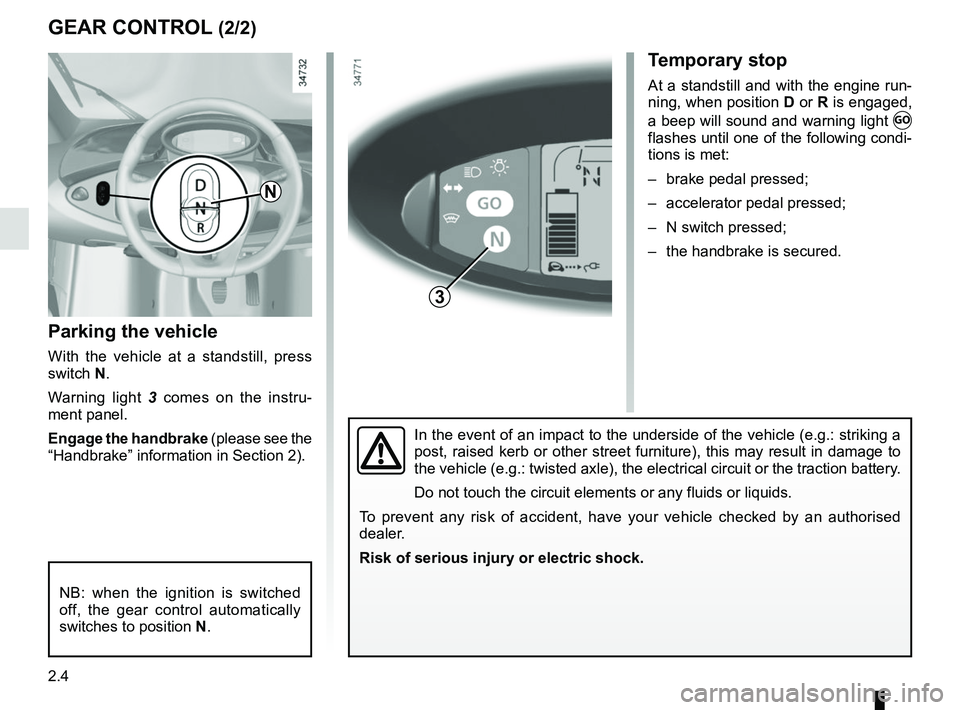
2.4
Parking the vehicle
With the vehicle at a standstill, press
switch N.
Warning light 3 comes on the instru-
ment panel.
Engage the handbrake (please see the
“Handbrake” information in Section 2).
GEAR CONTROL (2/2)
In the event of an impact to the underside of the vehicle (e.g.: striki\
ng a
post, raised kerb or other street furniture), this may result in damage\
to
the vehicle (e.g.: twisted axle), the electrical circuit or the tracti\
on battery.
Do not touch the circuit elements or any fluids or liquids.
To prevent any risk of accident, have your vehicle checked by an authoris\
ed
dealer.
Risk of serious injury or electric shock.
N
3
NB: when the ignition is switched
off, the gear control automatically
switches to position N.
Temporary stop
At a standstill and with the engine run-
ning, when position D or R is engaged,
a beep will sound and warning light
Ṑ
flashes until one of the following condi-
tions is met:
– brake pedal pressed;
– accelerator pedal pressed;
– N switch pressed;
– the handbrake is secured.
Page 60 of 118
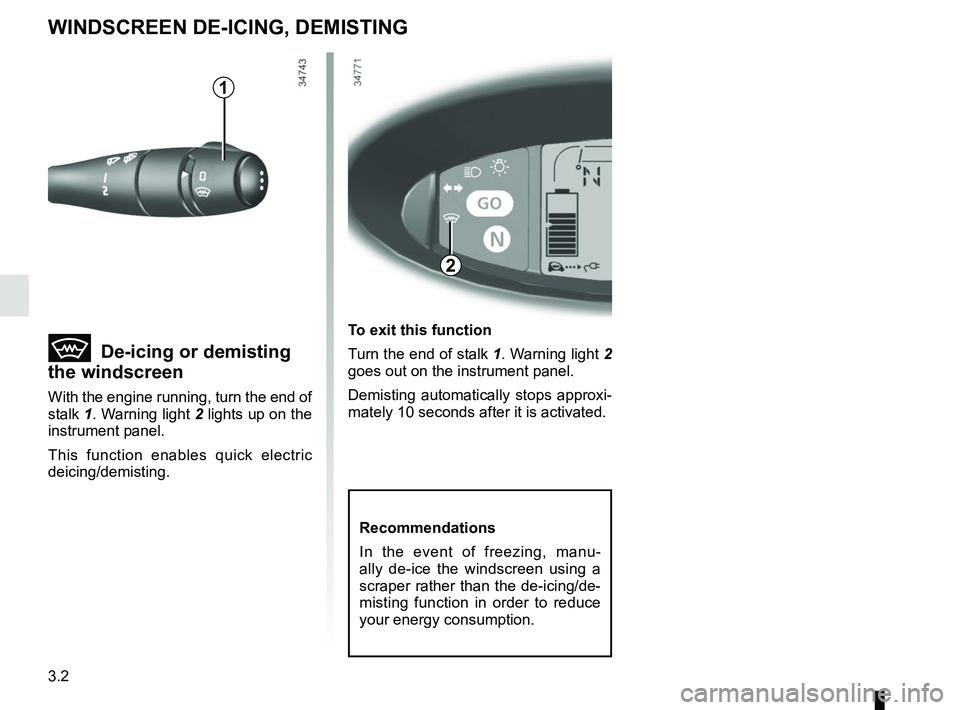
3.2
WINDSCREEN DE-ICING, DEMISTING
1
De-icing or demisting
the windscreen
With the engine running, turn the end of
stalk 1. Warning light 2 lights up on the
instrument panel.
This function enables quick electric
deicing/demisting.
To exit this function
Turn the end of stalk 1. Warning light 2
goes out on the instrument panel.
Demisting automatically stops approxi-
mately 10 seconds after it is activated.
2
Recommendations
In the event of freezing, manu-
ally de-ice the windscreen using a
scraper rather than the de-icing/de-
misting function in order to reduce
your energy consumption.
Page 70 of 118
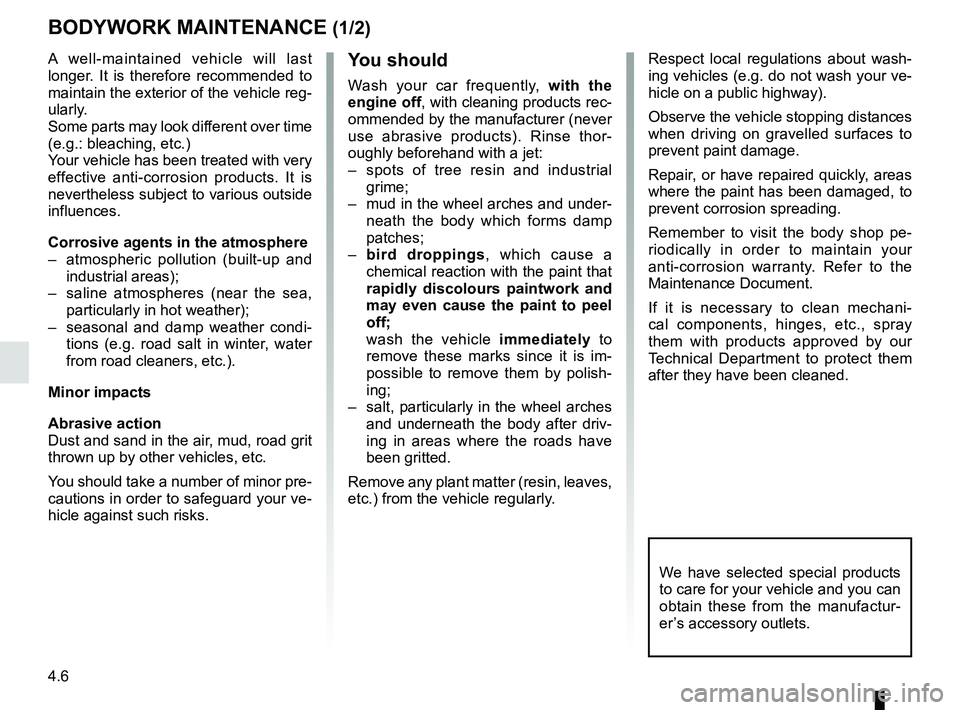
4.6
BODYWORK MAINTENANCE (1/2)
A well-maintained vehicle will last
longer. It is therefore recommended to
maintain the exterior of the vehicle reg-
ularly.
Some parts may look different over time
(e.g.: bleaching, etc.)
Your vehicle has been treated with very
effective anti-corrosion products. It is
nevertheless subject to various outside
influences.
Corrosive agents in the atmosphere
– atmospheric pollution (built-up and
industrial areas);
– saline atmospheres (near the sea,
particularly in hot weather);
– seasonal and damp weather condi-
tions (e.g. road salt in winter, water
from road cleaners, etc.).
Minor impacts
Abrasive action
Dust and sand in the air, mud, road grit
thrown up by other vehicles, etc.
You should take a number of minor pre-
cautions in order to safeguard your ve-
hicle against such risks.You should
Wash your car frequently, with the
engine off , with cleaning products rec-
ommended by the manufacturer (never
use abrasive products). Rinse thor-
oughly beforehand with a jet:
– spots of tree resin and industrial
grime;
– mud in the wheel arches and under-
neath the body which forms damp
patches;
– bird droppings , which cause a
chemical reaction with the paint that
rapidly discolours paintwork and
may even cause the paint to peel
off;
wash the vehicle immediately to
remove these marks since it is im-
possible to remove them by polish-
ing;
– salt, particularly in the wheel arches
and underneath the body after driv-
ing in areas where the roads have
been gritted.
Remove any plant matter (resin, leaves,
etc.) from the vehicle regularly. Respect local regulations about wash-
ing vehicles (e.g. do not wash your ve-
hicle on a public highway).
Observe the vehicle stopping distances
when driving on gravelled surfaces to
prevent paint damage.
Repair, or have repaired quickly, areas
where the paint has been damaged, to
prevent corrosion spreading.
Remember to visit the body shop pe-
riodically in order to maintain your
anti-corrosion warranty. Refer to the
Maintenance Document.
If it is necessary to clean mechani-
cal components, hinges, etc., spray
them with products approved by our
Technical Department to protect them
after they have been cleaned.
We have selected special products
to care for your vehicle and you can
obtain these from the manufactur-
er’s accessory outlets.
Page 71 of 118
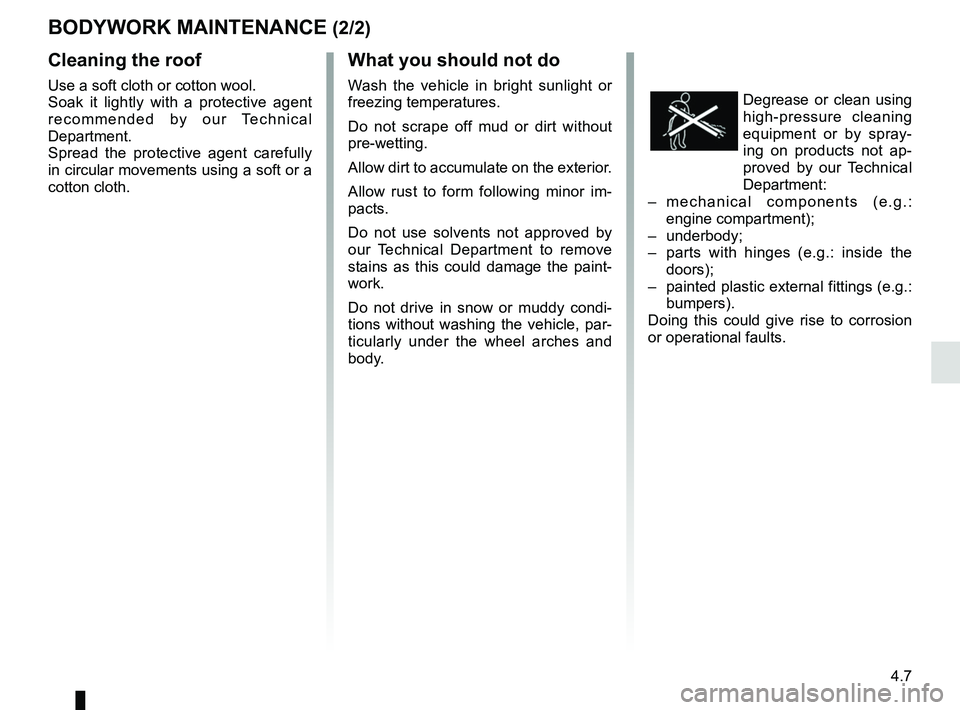
4.7
BODYWORK MAINTENANCE (2/2)
Cleaning the roof
Use a soft cloth or cotton wool.
Soak it lightly with a protective agent
recommended by our Technical
Department.
Spread the protective agent carefully
in circular movements using a soft or a
cotton cloth.
What you should not do
Wash the vehicle in bright sunlight or
freezing temperatures.
Do not scrape off mud or dirt without
pre-wetting.
Allow dirt to accumulate on the exterior.
Allow rust to form following minor im-
pacts.
Do not use solvents not approved by
our Technical Department to remove
stains as this could damage the paint-
work.
Do not drive in snow or muddy condi-
tions without washing the vehicle, par-
ticularly under the wheel arches and
body.Degrease or clean using
high-pressure cleaning
equipment or by spray-
ing on products not ap-
proved by our Technical
Department:
– mechanical components (e.g.:
engine compartment);
– underbody;
– parts with hinges (e.g.: inside the
doors);
– painted plastic external fittings (e.g.:
bumpers).
Doing this could give rise to corrosion
or operational faults.